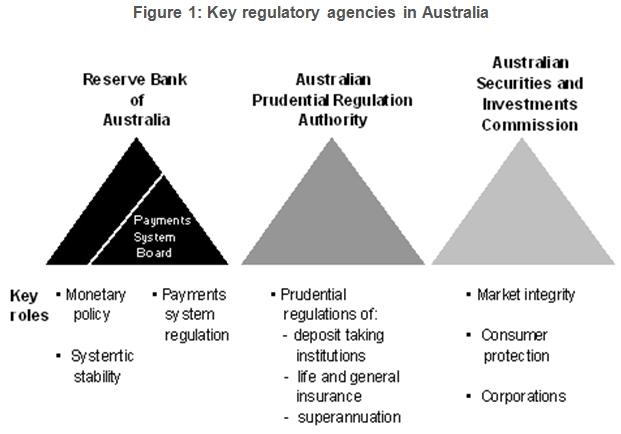In 1998, following the release of the Financial System (‘Wallis’) Inquiry’s final recommendations on financial system regulation, the Australian Government implemented a new organisational framework for the regulation of the financial system.
Prior to the Wallis Inquiry, regulation was either governed by the states for some products or based on a sectoral approach with industry specific regulation. The Inquiry recommended that regulation be nationalised and based on functional objectives, with three ‘peaks’ — a single prudential regulator (the Australian Prudential Regulation Authority (APRA)), a regulator for consumer protection and market integrity (the Australian Securities and Investment Commission (ASIC)), and an institution responsible for systemic stability and payments, as well as setting interest rates (the Reserve Bank of Australia) (RBA) (see below).

These arrangements were designed to ensure that regulation was consistent for similar financial products. And having lost its responsibility for bank prudential supervision, the RBA was left to focus more or less exclusively on inflation targeting.
For the first decade or so, the new structure appeared to work well, with the Australian economy growing strongly whilst inflation remained stable, in line with the ‘The Great Moderation’ taking place across the developed world.
But over recent years, the cracks have begun to appear in Australia’s financial regulatory model, which is now in need of an update.
First, the conga-line of recent financial scandals suggests that the regulator for consumer protection and market integrity – ASIC – is failing in its job – a task made more difficult by recent funding cuts from the Coalition Government, which it now promises to restore. Banking scandals have become endemic, as evident by the high number of loan frauds, along with events like the CommInsure scandal.
It is events like these, along with ASIC’s impotency, that has led MB to support a banking Royal Commission, which seems to be the only way of getting to the bottom of these issues.
However, a bigger regulatory issue, in our view, is the separation of powers between APRA and the RBA. As noted above, APRA is responsible for prudential regulation and maintaining lending standards, whereas the RBA is largely responsible for managing the cost of credit via interest rates.
This separation of powers is not working in Australia’s favour. Over recent years, we have had the RBA lowering the cost of credit (via dropping interest rates) in a bid buttress the economy against the end of the mining boom, lower the Australian dollar, and improve the competiveness of the non-mining trade-exposed economy.
Unfortunately, this lowering of interest rates has also reflated Australia’s housing and private debt bubble, leaving the economy and financial system vulnerable to a bust down the track.
The reason why the housing market has inflated so much is because APRA has been completely delinquent in acting to bolster lending standards, which itself admitted had fallen to horribly low levels last year, and only acted belatedly to implement a timid 10% ‘speed limit’ on investor lending, which was still some four times the speed of nominal GDP and way too generous.
It seems when everyone is responsible, nobody is responsible. And as long as the RBA’s and APRA’s powers on mortgage lending are separated, they will continue to work at cross-purposes. Neither party will claim responsibility for the ‘bubble’ and both will continue to be able to ‘look the other way’.
While we can’t be sure that the RBA would have acted much differently to rein-in dodgy lending practices in the event that it was also the prudential regulator – given its numerous speeches against macro-prudential in 2013 and 2014 – at least it would have ‘owned the bubble’ and would have been responsible for any fall-out each and every time that it cut interest rates.
In my view, Australia should adopt the New Zealand approach, whereby the Reserve Bank of New Zealand (RBNZ) has responsibility for both monetary policy and prudential regulation. This joint responsibility has seen the RBNZ take a much more ‘hands-on’ and transparent approach to managing housing risks, including the early implementation of macro-prudential curbs and frequent adjustments, along with frequent stern ‘jawboning’ of housing risks to the community.
The RBNZ’s ‘frank and fearless’ assessments have also shamed the country’s politicians to act on housing supply – something that is totally lacking from Australia’s financial regulators, who rarely speak-out and put pressure on our policy makers to reform the housing system.
It is also worth pointing-out that in 2011, the Bank of England resumed responsibility for both monetary policy and prudential supervision, taking back control from the failed Financial Services Authority (FSA) after 14 years following a post-mortem review of the financial crisis.
In short, there are two strong precedents for the RBA resuming control of both monetary policy and prudential supervision, in a bid to centralise responsibility and reduce blame shifting. This way, the RBA would ‘own the bubble’, and would be forced to stem the flow of mortgage credit as it cuts interest rates.
It’s time for reform of Australia’s financial regulatory system, which is not functioning optimally.

